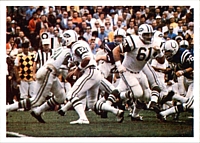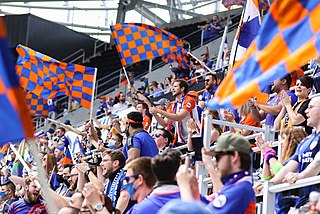Related Research Articles

The American Football League (AFL) was a major professional American football league that operated for ten seasons from 1960 until 1970, when it merged with the older National Football League (NFL), and became the American Football Conference. The upstart AFL operated in direct competition with the more established NFL throughout its existence. It was more successful than earlier rivals to the NFL with the same name, the 1926, 1936 and 1940 leagues, and the later All-America Football Conference.
Buffalo, New York had a turbulent, early-era National Football League team that operated under multiple names and several different owners between the 1910s and 1920s. The early NFL-era franchise was variously called the Buffalo All-Stars from 1915 to 1917, Buffalo Niagaras in 1918, the Buffalo Prospects in 1919, Buffalo All-Americans from 1920 to 1923, Buffalo Bisons from 1924 to 1925 and in 1927 and 1929, and the Buffalo Rangers in 1926. The franchise, which was experiencing financial problems in 1928, did not participate in league play that season.
Below is a list of professional football Championship Games in the United States, involving:
Horst Herbert Erich Mühlmann was a professional footballer and American football player. He was a placekicker in the American Football League (AFL) and the National Football League (NFL) for nine seasons. He played for the Kansas City Chiefs (1969), the Cincinnati Bengals (1969–1974) and the Philadelphia Eagles (1975–1977).
The Cincinnati Bengals were a short-lived professional football team that played in Cincinnati, Ohio. It is unrelated to the current Cincinnati Bengals. Originated by Hal Pennington, the team was formed as a member of the second American Football League in the 1937 season. The Bengals finished with a 2–3–2 record in their first year, but the league folded after the season, and Pennington returned to his former team, the Cincinnati Models, which would change its name to the Cincinnati Blades for an ill-fated 1938 campaign. Pennington was replaced by new player-coach Dana King, who would guide the Bengals for the remainder of the team's existence.

The 1968 AFL season was the ninth regular season of the American Football League, and its penultimate season prior to the AFL–NFL merger.
The American Football League, also known retrospectively as the AFL III to distinguish it from earlier organizations of that name, was a professional American football league that operated from 1940 to 1941. It was created when three teams, the original Cincinnati Bengals, the Columbus Bullies, and the Milwaukee Chiefs, were lured away from the minor-league American Professional Football Association and joined three new franchises in Boston, Buffalo, and New York City in a new league. It competed against the National Football League (NFL), the oldest existing professional football league, which had been established in 1920 and reorganized in 1922.
The American Football League (AFL) was a professional American football league that operated in 1936 and 1937. The AFL operated in direct competition with the more established National Football League (NFL) throughout its existence. While the American media generally ignored its operation, this second AFL was the first "home" of the Cleveland Rams, which joined the National Football League after one year in the AFL.
The Midwest Football League (MFL) was a professional American football minor league that existed from 1935 to 1940. Originally comprising teams from Ohio, Kentucky, Indiana, and Illinois, the league eventually expanded its reach to include teams from Missouri, Tennessee, Wisconsin, and California to become a national league with major league aspirations by 1939. In 1938, the league became the American Professional Football League after the collapse of the second major league of the same name, but changed its name once again the following year to American Professional Football Association (APFA). Some sources refer to it as the American Professional Football League.

The Columbus Bullies were a professional football team founded by Dean Carter in Columbus, Ohio, in 1938. The Bullies started out as a member of the American Professional Football Association (APFA) in 1939. Later, in 1940, the Bullies joined the Cincinnati Bengals and Milwaukee Chiefs in leaving the APFA and becoming charter members of a new American Football League. Playing in Red Bird Stadium, the Bullies won both AFL Championships prior to ceasing operations when the AFL disbanded due to World War II. The Bullies defeated the Milwaukee Chiefs in 1940, and the New York Americans in 1941 in the only two AFL Championships.

The Los Angeles Bulldogs were a professional American football team that competed from 1936 to 1948. Formed with the intention of joining the National Football League in 1937, the Bulldogs were the first team on the major league level to play its home games on the American West Coast. They were considered "the best football team in existence outside the NFL".
The American Association (AA) was a professional American football minor league based in New York City. Founded in 1936 with teams in New York and New Jersey, the AA extended its reach to Providence, Rhode Island prior to the onset of World War II. After a four-year hiatus, the league was renamed the American Football League as it expanded to include teams in Ohio and Pennsylvania. In 1947, the Richmond Rebels of the Dixie League purchased the assets of the defunct AFL Long Island Indians and jumped leagues.
The New York Yankees of the third American Football League was the third professional American football team competing under that name. It is unrelated to the Yankees of the first AFL, the Yankees of the second AFL, and the (later) Yankees of the All-America Football Conference. The Yankees played their home games in Yankee Stadium and Downing Stadium in New York, New York.
The 1941 AFL season was the second and final season of the third American Football League. After deeming the 1940 season to be a success, the league made overtures of expansion, even going to the point of having a press conference to announce the addition of new teams (July), but when the press conference was held, the Boston Bears had withdrawn from the league and the new Detroit franchise deferred entry for the 1942 season.
The Buffalo Indians were a professional American football team that competed in the third American Football League in 1940 and in 1941. The team played its home games in Civic Stadium in Buffalo, New York. Owned by the Buffalo American Legion, the Indians were managed by Earl "Red" Seick, who was also player-coach for the team for the first five games in 1940. While most of the AFL membership focused on raiding the rosters of the local members of the National Football League teams, the Indians concentrated on signing local talent, castoffs from the NFL, and men who played in the defunct second American Football League.
The Milwaukee Chiefs were a professional American football team based in Wisconsin that competed in the third American Football League in 1940 and in 1941.
The Boston Bears were a professional American football team that competed in the third American Football League in 1940. Owned by Sheldon H. Fairbanks, the team played its home games in the Fenway Park in Boston, Massachusetts. Coach Eddie Casey’s team was a competitive one, finishing the 1940 season with a 5-4-1 record, good for third place in the AFL, behind league champions Columbus Bullies and second-place Milwaukee Chiefs.
The Louisville Tanks were a minor league professional American football team that existed from 1935 to 1940. The team formed in the wake of the dissolution of the Louisville Bourbons of the short-lived American Football League of 1934. Organized and owned by American Standard, Inc., the team was coached by AS plant manager H.M. "Harry" Reed; its name and colors come from one of the products sold by American Standard. The Tanks played their home games at Parkway Field in Louisville, Kentucky, USA.
Robert Joseph Eckl was a professional American football player in the National Football League as a tackle for the Chicago Cardinals in 1945. Prior to that he played for the Milwaukee Chiefs of the third American Football League. In 1940 Eckl was elected to the All-AFL, with 1st team honors. A year later, he remained in the AFL, and split the season between the Chiefs and the Cincinnati Bengals.

Ohio is home to many professional and college sports teams. The metropolitan areas of Cleveland, Cincinnati, and Columbus are home to major league professional sports teams in baseball, basketball, football, hockey, and soccer.
References
- ↑ George Gipe, The Great American Sports Book (Doubleday 1978) ISBN 0-385-13091-0
- ↑ History of Professional Football in Western New York Archived 2016-03-03 at the Wayback Machine
- ↑ "Enciclopedia del football italiano - 1940 AFL season" (PDF). Archived from the original (PDF) on 2011-07-22. Retrieved 2008-11-10.
- 1 2 Gill, Bob (1983). "The Best of the Rest, Part 2" (PDF). The Coffin Corner. 5 (12). Professional Football Researchers Association. Archived from the original (PDF) on 2010-11-27. Retrieved 11 February 2010.